Sample Preparation for Large-Scale Protein Purification
The two most popular mechanical techniques for sample preparation for large-scale protein production are concussion and liquid shear.
Technological advances in drug development and biological sciences are allowing for the rapid development of new diagnostic methods and drugs based upon biological molecules. Protein drugs such as insulin, human growth hormone and erythropoietin have proven to be effective in the treatment of diseases. Such pharmaceuticals are the most rapidly growing segment of the prescription drug market. More than 15 protein drugs are on the market (not including macromolecules such as vaccines and antibodies) and more than 250 in clinical studies worldwide. As more and more protein-based drugs move down the drug development pipeline, reliable methods of scaling up to large-scale, pilot- and finally process purification are required. Even though some of these drugs are fairly potent with microgram amounts providing therapeutic levels, gram-to-kilogram quantities of purified substance might still be needed. Compared with drugs based upon small molecules, proteins are large, vary in size, shape, charge, and hydrophobicity, are sometimes "sticky" and often are unstable, so scale-up represents a considerable challenge from a recovery and purity standpoint. Along the way, analysis must be performed to ensure that the protein has not changed during the handling steps.
The isolation of proteins starts with sample preparation, followed by protein separation, then characterization and finally image analysis. Scientists who want to isolate large quantities of proteins from start to finish must use a variety of approaches.
The first step of proteomics research involves the isolation of proteins from a biological sample. This instalment of "Sample Preparation Perspectives" will discuss typical methods that can be used to recover large amounts of proteins from biological samples such as cells, fermentation products, and so on. These methods can differ from the isolation of microgram amounts for research purposes in the laboratory.
Cell Disruption (Lysis) Methods
Many of the proteins of interest are contained within cells that may be of animal or plant origin. The protein content of cells must be released before further separation and purification. All cells have a plasma membrane, a protein–lipid bilayer that forms a barrier separating cell contents from the extracellular environment. Lipids comprising the plasma membrane are amphipathic, having hydrophilic and hydrophobic moieties. Membrane proteins are embedded in the lipid bilayer. In addition, peripheral proteins bind the inner or outer surface of the bilayer through interactions with integral membrane proteins or with polar lipid head groups. The nature of the lipid and protein content varies with cell type. Thus, different types of cells can require a different lysis method to break the cell membrane barrier.
Plant cell walls are particularly strong, making them very difficult to disrupt mechanically or chemically. Lysis of yeast cells requires mechanical disruption using glass beads, whereas bacterial cell walls are the easiest to break compared with these other cell types. The lack of an extracellular wall in animal cells makes them relatively easy to lyse.
Cell disruption is a sensitive process because of the cell wall's resistance to the high osmotic pressure inside them. Furthermore, difficulties arise from a noncontrolled cell disruption. Uncontrolled cell disruption can result in a release of all intracellular products (proteins, nucleic acids, cell debris) that can present separation challenges downstream. In addition, the cell disruption process must occur without the desired product's denaturation. There are two basic approaches to disrupt cell walls: nonmechanical (chemical) methods and mechanical (physical) methods.
Chemical methods: Chemical methods allow penetration of the cell wall barriers. Treatment with organic solvents such as toluene, ether, phenylethyl alcohol, dimethyl sulphoxide (DMSO), methanol and the like creates canals through the cell membranes. Chemical methods such as treatment with detergents, enzymes, alkali, chelates and chaotropic agents also allow cell wall permeation and are quite effective but introduce additional chemical compounds in the mixture that can require later removal from the purified materials. Detergents can be ionic, such as sodium dodecyl sulphate or nonionic such as Tween. Nonionic detergents are considered to be gentler. Enzymatic permeabilization with enzymatic agents such as lysozyme is used for E. coli, which has tough cell walls. These added proteins could cause problems down the road. For example, enzymes derived from eggs can cause problems if trace amounts remain in the purified protein that will be used as a therapeutic, because some people are allergic to eggs. Yeasts and snail gut enzyme are generally not used for scale-up either because they are mixtures of enzymes. The main drawbacks for the use of enzymes in large-scale processing are cost and the necessity of removing the enzyme from the product. Chaotropic agents such as urea and guanidine are capable of bringing some hydrophobic compounds into aqueous solution by disrupting the structure of water. This disruption makes the environment less hydrophilic and weakens the hydrophobic interactions among solute molecules. Alkali at pH 12–13 breaks cell wall membranes, but this high pH can affect certain proteins.
Osmotic shock is a nonmechanical treatment that exposes cells to rapid changes in extracellular osmotic pressure that causes mechanical injury. Osmotic shock typically is conducted by first allowing the cells to equilibrate their internal and external osmotic pressure in a high sucrose or salt medium, and then rapidly diluting the solution with distilled water. It is the resulting immediate overpressure of the cytosol that is assumed to damage the cell membrane.
In general, for scale-up, it can be safely stated that the addition of chemical agents is to be avoided because of their added expense and removal requirements, especially for protein-based molecules.
Mechanical methods: Mechanical (physical) disruption methods are preferred for large scale-up operations. Physical methods do not require the addition of reagents so that less clean-up is needed downstream. In the physical methods, intracellular products are released from microorganisms by mechanical disruption of the cells. The cell envelope is broken physically, and the intracellular components are released into the surrounding medium. The most popular physical techniques appropriate for large volumes of cell media are ultrasonication, freeze–thaw, concussion and liquid shear. Sonication generates cavitation in a solution that causes cell walls to disintegrate, thereby releasing their contents. Because it is costly, sonication is used mainly in laboratory scale for lysis of cells with less resistant cell walls such as bacteria and fungi. In addition, there is heat generation that can denature protein. Freeze-thaw is a technique where the cell-containing solution is frozen repeatedly in a dry ice-ethanol bath and then thawed to room temperature. Repeated freezing and thawing of cells disrupts them because of the repeated formation of sharp ice crystals, many beginning to grow in the inside of the cells. This cycling process is quite lengthy. Again, this technique is difficult to employ for large-scale production.
The two most popular mechanical techniques for sample preparation for large-scale protein production are concussion and liquid shear. One concussion device is the ball mill, in which the cells are agitated in suspension with small abrasive particles such as glass beads, silica or sand. Cell walls are broken by shear forces of the grinding action of rolling beads and from the impact resulting from collision with cascading beads. Bead milling can generate enormous amounts of heat and, therefore, a jacketed coolant is used to keep temperatures in the 4–25 °C range. Sometimes cryogenic bead milling is employed with liquid nitrogen or glycol cooling. For the production of large quantities of material, a continuous mill is preferred. Figure 1 depicts a schematic of a Dyno Mill KDL Type (Willy.A.Bachofen AG, Basle, Switzerland) that is a continuously operating ball mill with a horizontal grinding container. An external pump supplies product to the mill. Specially designed agitator discs, mounted symmetrically on a shaft, transfer the energy required for dispersion to the spherical glass grinding beads. The jacketed chamber is cooled via an external chiller to keep the material at optimal temperatures. For this particular manufacturer, models with up to 40 L/h capacity are available. A reservoir collects the disrupted cell contents.
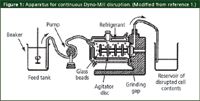
Figure 1: Apparatus for continuous Dyno-Mill disruption. (Modified from reference 1.)
Liquid shear mechanical devices, also known as homogenizers, pump a slurry of sample at high pressure through a restricted orifice valve. As the cells pass through the homogenizer, there are three mechanisms of cell disruption: impingement on the valve; high liquid shear in the orifice; and sudden pressure drop upon discharge, which combine to cause an instant expansion of the cell. Heat is also generated in the homogenizer and provisions must be made to cool it to prevent breakdown or denaturing of the proteins of interest. The high-pressure homogenizer is used mainly for the release of intracellular molecules.
A colloid mill is another approach to mechanical cell disruption. As shown in Figure 2, a cell suspension is continuously fed into a centrifugal device rotating at 10000–50000 rpm, which subjects the cells to high shear and turbulence. This results in cell disruption, and the disrupted cells are removed continuously from the colloid mill, as shown in the figure. The colloid mill works well for tissue-based material.
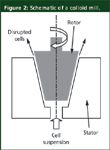
Figure 2: Schematic of a colloid mill.
A French press, schematically depicted in Figure 3, is a mechanical device that is used for small-scale recovery of intracellular proteins and DNA from bacterial and plant cells. A French press uses high pressure (about 10000–50000 psi) applied to a cell suspension. Such extreme conditions cause lysis of the cell and release of all proteins within the cell. Once the French press is complete, the target protein is isolated from the protein slurry created during cell lysis. The mechanism of mechanical disruption is the high shear rates within the orifice as well as impingement against the impact plate. The French press is not scaled easily to process conditions.
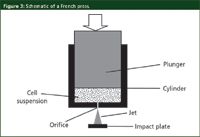
Figure 3: Schematic of a French press.
There are some drawbacks to the mechanical disruption methods. Because cells are broken completely, all intracellular materials are released. The product of interest must then be separated from a complex mixture of proteins, nucleic acids and cell wall fragments. Released nucleic acids can increase the viscosity and complicate subsequent processing steps such as chromatography. Because cells disrupt at different times, the viscosity of the medium changes constantly and the released subcellular components are subjected to disruptive forces. Cell debris, which consists of small cell fragments, makes the resulting output difficult to clarify by continuous centrifugation or filtration, especially if multiple passes are used to obtain complete product release. Multiple passes through mechanical agitation devices causes even further division of cell fragments. Heating of the cell suspension during high mechanical agitation can cause protein denaturation and aggregation. Samples must be kept cool or on ice during the disruption process. Some of the mechanical equipment is expensive and cannot be scaled up for process applications.
Cell Disruption Aids
Cells can be treated with various chemicals to aid the disruption process. Lysis can be promoted by suspending cells in a hypotonic buffer, which causes them to swell and burst more readily under physical shearing. Lysozyme can be used to digest the polysaccharide component of yeast and bacterial cell walls. Alternatively, treating cells with glass or ceramic beads can expedite processing in order to facilitate the crushing of cell walls. This procedure is used commonly with yeast cells. Because viscosity of a sample typically increases during lysis as a resolve of the release of nucleic acid material, DNase (25–50 μg/mL) and RNase (50 μg/mL) can be added to samples to reduce this problem.2 Finally, with cell manipulation, proteolysis can be a problem; therefore, protease inhibitors should be added to samples undergoing lysis.
Clarification of Disrupted Cellular Materials
Before further downstream processing, the cell debris must be separated from the liquid portion. There are several approaches for the separation of the liquid and solid materials: centrifugation; filtration; and flocculation and aggregation.
Centrifugation: Centrifugation is a process used to separate or concentrate materials suspended in a liquid medium. The theoretical basis of this technique is the effect of gravity on particles (including macromolecules) in suspension (Stokes' law). Two particles of different masses will settle in a tube at different rates in response to gravity. Large particles will settle faster than small particles. Centrifugal force (measured as g, gravity) is used to increase this settling rate in a centrifuge. The most common technique, called differential centrifugation, is used to separate particles from a liquid medium or to separate particles of different masses into separate fractions of the supernatant. At the appropriate centrifugal angular velocity and rotation radius, cellular debris from the disruption process will form a pellet at the bottom of the centrifuge tube but the intracellular material, which is soluble, will remain in the supernatant.
Centrifuges are devices used in a variety of scientific and technical applications that spin carrier vessels (centrifuge tubes) at high rotation speeds and very high centrifugal force. The centrifugal force generated is proportional to the rotation rate of the rotor (in rpm) and the distance between the rotor centre and the centrifuge tube. Therefore, a given centrifuge can use multiple rotor sizes to give flexibility in choosing centrifugation conditions.
Typically, the material to be "spun" is placed in a centrifuge tube that is, in turn, placed in a rotor. The rotor is constructed with dense metal that dissipates heat quickly, and is of sufficient mass that it generates momentum; that is, once it is spinning, it requires little energy to keep it going. Centrifuges generally work under vacuum and are refrigerated to reduce heating caused by frictional forces as the rotor spins. Rotors are usually stored in refrigeration units to keep them at or near the operating temperature.
There are a variety of centrifuges for both laboratory and process scale. Each will provide a different performance in terms of volume handled, g-force, particle size range, discharge method, configuration, and so on. The typical laboratory angle-swing out (swinging bucket) centrifuge has a small volume that is insufficient for a process-scale operation. Typically, sustained g-forces greater than 12000 g are necessary to clarify homogenized microorganisms. Ultracentrifuges, with speeds in the 70000 rpm range, can separate small particles such as ribosomes. Process-scale centrifuges can separate particles in the range of 0.1–200 μm in diameter and can run continuously.
For process applications, large-scale continuous centrifuges such as the solid bowl-scroll centrifuge and the disc stack centrifuge are used. For the solid bowl-scroll type decanter centrifuge (see Figure 4), cell slurry is fed through a stationary pipe into the feed zone, located in the centre of the scroll. The product is then accelerated circumferentially and delivered through distribution ports into the bowl. The bowl has a cylindrical, conical shape and rotates at a preset speed optimal for the application. The slurry rotates with the bowl and forms a concentric layer at the bowl wall. The solids in the slurry are deposited against the bowl wall by the centrifugal force. The scroll rotates at a slightly different speed than the bowl and conveys the deposited solids towards the conical end of the bowl. The differential speed determines the residence time of the solids in the bowl and governs the dry solids content. The supernatant liquid containing the desired clarified cell content is directed to a collection device either by gravity discharge or with discharge under pressure. Up to 10000 g of centrifugal force can be generated in the solid bowl-scroll type of continuous centrifuge. Decanter centrifuges are generally used for greater solids concentration with larger particle sizes.
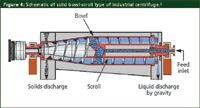
Figure 4: Schematic of solid bowl-scroll type of industrial centrifuge.3
The disc stack centrifuge (Figure 5) is another continuous device used for industrial scale removal of solid materials from cell slurries. A disc stack centrifuge separates solids and one or two liquid phases from each other in a single continuous process using extremely high centrifugal forces. When denser solids are subjected to such forces, they are forced outwards against a rotating bowl wall while the less dense liquid phases form concentric inner layers. Inserting special stainless steel plates called the disc stack provides additional surface-settling area that speeds up the separation process dramatically. The shape and design of these plates makes it possible for the disc stack centrifuge to perform continuous separation of a wide range of solids from liquids. The concentrated solids phase formed by the cell debris can be removed continuously, intermittently or manually depending upon the need. Disc stack centrifuges are used for lower solids concentrations and smaller particle sizes than decanter type centrifuges.
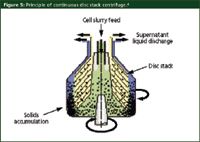
Figure 5: Principle of continuous disc stack centrifuge.4
Filtration: Filtration separates liquids from solids on the basis of particle size. The specific case of microfiltration contaminants in the size range of 0.1–10.0 μm are removed from fluids by passage through a microporous medium such as a membrane. The efficiency of filtration is limited by the shape and compressibility of the particles, the viscosity of the liquid phase and the maximum allowable pressure. Dead-end filtration [Figure 6(a)], sometimes referred to as normal filtration, employs a porous filter that can be constructed of paper, stainless steel, ceramic, or most likely, a microporous polymeric membrane. According to equation 1, the volumetric throughput of a filter w is proportional to the pressure (P) and filter area (A) and inversely proportional to the filter cake thickness (D) and the dynamic viscosity (η)

where k is a constant dependent upon the size and nature of the particles. When using a dead-end filtration technique, all the fluid passes through the membrane, and all particles larger than the pore sizes of the membrane are stopped at its surface. Their size prevents them from entering and passing through the filter medium. This means that the trapped particles start to build up a "filter cake" on the surface of the medium, which reduces the efficiency of the filtration process. If particles block the filter bed because of particle compression and cake build-up, equation 1 is no longer applicable. Sometimes filter aids such as diatomaceous earth are mixed with the feedstock to improve the mechanical strength of the filter cake. The filter aid can influence the recovery of enzyme activity and can be difficult to use if the solid portion (filter cake) is of interest, so it is only used when necessary.
The problem of build-up of the filter cake can be avoided by using a high tangential flow of the feedstock across the surface of the filter [Figure 6(b)]. This process is known as cross-flow filtration. In cross-flow filtration, a pressure differential across the membrane is generated. This causes some of the particles to pass through the membrane. Remaining particles continue to flow across the membrane, "cleaning it". In contrast to the dead-end filtration technique, the use of a tangential flow will prevent thicker particles from building up a "filter cake". Unlike single-pass filtration methods, cross-flow filtration involves recirculation of the feed stream across the membrane surface.
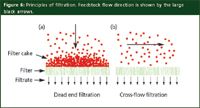
Figure 6: Principles of filtration. Feedstock flow direction is shown by the large black arrows.
Crossflow operations typically fall into one of three categories based upon the size of components being separated: ultrafiltration, micro- and nanofiltration, and "hyperfiltration", this last process more commonly referred to as reverse osmosis. Microfiltration is usually used upstream in a recovery process to separate intact cells and some cell debris–lysates from the rest of the components in the feed stream. Either the retained cells or the clarified filtrate can be the product stream. Membrane pore size cut-offs used for this type of separation are typically in the range of 0.05–1.0 μm.
Ultrafiltration is a process similar to microfiltration–nanofiltration. The main difference is the "tighter" retention behaviour: The ultrafiltration membrane retains much smaller particles from the passage through the membrane than do microfiltration membranes. Typically, the particle size is measured by molecular weight, and ultrafiltration membranes have retention ranges from 1000 to 1000000 molecular weight. Ultrafiltration membranes are available in several different materials to suit a wide range of applications. The different membrane materials offer alternatives in fouling characteristics and chemical compatibility. Each of the membrane materials is available in a number of nominal molecular weight limits. Examples of low protein-binding materials for ultrafiltration membranes are regenerated cellulose, cellulose acetate, polysulphone, polyacrylonitrile–polyvinylchloride copolymers and modified polyethersulphone. Ultrafiltration is used to separate proteins from buffer components for buffer exchange, desalting or concentration.
Reverse osmosis and nanofiltration are types of cross flow filtration in which very tight membranes are used to separate salts and small molecules with molecular masses typically lower than 1500 Da from water or other solvents. Membranes with nominal molecular weight limits of 1 kDa and lower are used.
Flocculation and coagulation: Sometimes very small particles are held in suspension by electrostatic surface charges. These charges cause clouds of counterions to form around the particles giving rise to repulsive forces that prevent aggregration and reduce the effectiveness of downstream separation processes. Flocculation and coagulation agents aid centrifugation and filtration by overcoming these repulsive forces and increase the diameter of particles through aggregation for faster sedimentation. Three main types of agents are inorganic electrolytes (such as alum, lime, ferric chloride, and ferrous sulphate or nickel, copper or zinc salts, which can operate through metal ion complex formation), high molecular weight organic polymers such as polyethylene glycol (PEG) and synthetic polyelectrolytes with cationic or anionic functional groups such as polyethyleneimine. Sometimes heat or pH adjustment around the protein's isoelectric point is used to decrease protein solubility. The addition of flocculents or coagulants is followed by low-shear mixing in a flocculator to promote contact between the particles, allowing particle growth through a sedimentation phenomenon termed flocculent settling. Experimental conditions must be derived to place the product in either the liquid or the solid fraction. Obviously, the protein must be stable to treatment with the flocculent or coagulant.
Product Concentration
After the clarification step, we now have our protein in a liquid solution, but its concentration can be very dilute. The next step is to concentrate the clarified protein solution quickly while keeping it in a stable state. Sometimes, especially with high effectiveness proteins, the concentration step can be avoided. There are several approaches to concentrating the protein solution. Protein solubility is a function of ionic strength and as you increase the ionic strength by adding salt, proteins will precipitate because their solubility drops sharply. This process is referred to as salting out. Ammonium sulphate is the most common salt used for this purpose because it is unusually soluble in cold buffers. Ammonium sulphate fractionation is used commonly in research laboratories as a first step in protein purification because it provides some crude purification of proteins away from nonproteins. Ammonium sulphate also yields precipitated protein slurry that is usually very stable. Other salts can be used. The slope of the salting-out curve is a function of the protein and salt involved. Also, as the molecular weight of the protein increases, the amount of salt required for precipitation decreases. Solubility tables can be useful for achieving the proper concentration for salting out to occur.
Proteins are usually soluble in water solutions because they have hydrophilic amino acids on their surfaces that attract water molecules and interact with them. This solubility is a function of the ionic strength and pH of the solution. Proteins have isoelectric points at which the charges of their amino acid side groups balance each other. If the ionic strength of a solution is either very high or very low, proteins will tend to precipitate at their isoelectric point.
Some of the clarification techniques reported earlier also result in protein concentration and isolation. For example, the addition of a water-soluble polymer such as PEG to a cold protein solution with stirring forces the protein out of solution for further separation by centrifugation or filtration. Also, the PEG tends to stabilize the protein solution. Ultrafiltration also is a very effective protein concentration technique and can be used in large-scale processes. It is effective in resolving proteins of close molecular size.
Organic solvent fractionation, used in the blood fractionation industry, will cause a precipitation but can also denature the protein, so such solvents should be avoided for recovery of intact protein. Finally, whenever any chemical is added to a protein solution for any reason, it must be removed or exchanged for further processing. Dialysis using selective permeable membrane is a technique that is fairly gentle and results in recovery of protein in the absence of salt or in a more preferable salt environment.
What's Next?
We now have our protein(s) in a solid or concentrated liquid form without cell debris but still might have undesirable proteins and other molecules present. Purification by ion-exchange, affinity, immunoaffinity, size exclusion (gel filtration), reversed-phase and hydrophobic interaction chromatography can result in a selective fractionation of a crude mixture. Detailed discussion of these chromatographic principles is beyond the scope of this sample preparation-oriented column, and the reader is referred to textbooks that cover chromatographic separations of protein mixtures.5–8
Conclusion
I have explored some of the sample preparation methods that are used in an industrial or process scale to clean-up mixtures of lysed cells. With many steps required to obtain concentrated protein mixtures, the reader should be aware that the integrity of the desired protein(s) must be maintained throughout the various treatments. Each step results in some loss of protein, so recovery is of primary interest, especially for expensive protein-based drugs. In addition, for recovery of intact proteins, often, the solutions must be kept cold during these treatments. Otherwise, sensitive samples can become denatured or unstable and break down into undesirable products or lose their biological activity. The degree of purity of injectable proteins is of utmost importance and contaminants, even at trace levels, can render the product unusable. Contaminants can be other proteins but also other cell contents like nucleic acids, lipids, carbohydrates, and so on. Purification processes must be very robust and reproducible and cannot result in variable activity or yield from run to run. Methods that work in a small-scale laboratory environment might not be feasible to scale-up to a process environment. Nevertheless, in view of the bright future of these protein-based pharmaceuticals in solving, preventing or detecting life-threatening illnesses, it is worthwhile to pursue and optimize these sample preparation technologies to ensure that sufficient quantities of purified material are available for continued research for diagnostic and medical purposes.
Ronald E. Majors is business development manager, Consumables and Accessories Business Unit, Agilent Technologies, Wilmington, Delaware, USA and is a member of the editorial advisory board of LCGC Europe. Direct correspondence about this column to LCGC Europe, Advanstar House, Park West, Sealand Road, Chester CH1 4RN, UK, e-mail: dhills@advanstar.com
References
1. J. Jung, X-H Xing, and K. Matsumoto, Biochem. Eng. J., 8, 1–7 (2001).
2. Pierce Biotechnology, Rockford, Illinois, USA (www.piercenet.com).
3. http://www.flottweg.com
4. Alfa Laval-Disc Stack Centrifuge Technology, http://www.alfalaval.com.
5. Protein Purification: Principles, High-Resolution Methods, and Applications, J.-C. Janson and L. Ryden, Eds. (John Wiley and Sons, Hoboken, New Jersey, USA 1998).
6. Protein Liquid Chromatography, Journal of Chromatography Library, 61, M. Kastner, Ed. (Elsevier Science, Amsterdam, The Netherlands, 2000).
7. R.L. Cunico, K.M. Gooding, and T. Wehr, Basic HPLC and CE of Biomolecules (Bay Bioanalytical Laboratory, Richmond, California, USA 1998).
8. M.-I. Aguilar, HPLC of Peptides and Proteins, Methods in Molecular Biology, 251 (Humana Press, Totowa, New Jersey, USA 2003).
New Method Explored for the Detection of CECs in Crops Irrigated with Contaminated Water
April 30th 2025This new study presents a validated QuEChERS–LC-MS/MS method for detecting eight persistent, mobile, and toxic substances in escarole, tomatoes, and tomato leaves irrigated with contaminated water.
University of Tasmania Researchers Explore Haloacetic Acid Determiniation in Water with capLC–MS
April 29th 2025Haloacetic acid detection has become important when analyzing drinking and swimming pool water. University of Tasmania researchers have begun applying capillary liquid chromatography as a means of detecting these substances.

.png&w=3840&q=75)

.png&w=3840&q=75)



.png&w=3840&q=75)



.png&w=3840&q=75)









